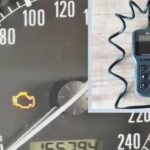The OBD2 code P1780 in Ford vehicles indicates a problem with the Transmission Control Switch (TCS). This article will delve into the P1780 code for Ford vehicles, its potential causes, related codes, and possible solutions. Understanding this code is crucial for diagnosing and fixing transmission issues.
Decoding the P1780 OBD2 Ford Code
The P1780 code specifically points to an issue with the Out of Self-Test Range for the Transmission Control Switch (TCS). The TCS, often located on the steering column or gear shift lever, allows the driver to select different gear ranges (Park, Reverse, Neutral, Drive, etc.). When the TCS malfunctions, the Powertrain Control Module (PCM) detects a signal outside the expected range, triggering the P1780 code. This can lead to various driveability problems.
Potential Causes of P1780 in Ford Vehicles
Several factors can contribute to a P1780 code:
- Faulty Transmission Control Switch (TCS): The most common culprit is a malfunctioning TCS itself. Wear and tear, internal damage, or electrical issues can disrupt its signal.
- Wiring Problems: Damaged, corroded, or loose wiring connecting the TCS to the PCM can interfere with signal transmission.
- PCM Issues: While less common, a faulty PCM can sometimes misinterpret signals or fail to communicate correctly with the TCS.
- Low Transmission Fluid: In some cases, low transmission fluid can indirectly cause the P1780 code.
Related OBD2 Codes in Ford Vehicles
While P1780 specifically relates to the TCS, other codes can accompany it or point to underlying issues contributing to the problem. These may include:
- U-Codes: These represent communication errors between modules, potentially affecting the TCS signal. Example: A U-code related to the body control module (BCM) might suggest a communication breakdown affecting the TCS.
- P132B (Turbocharger Boost Control “A” Position Exceeded Learning Limit): This points to a problem with the turbocharger system, which could indirectly affect fuel trim and potentially trigger a P1780 if the engine is not operating within expected parameters.
- P0170 (Fuel Trim Malfunction): This indicates an issue with the air/fuel mixture, potentially caused by a problem linked to the P132B code. If the turbocharger isn’t functioning correctly, it can affect the fuel mixture, potentially leading to a P1780.
- P04DB (Exhaust Gas Recirculation “A” Control Stuck Closed): Issues with the Exhaust Gas Recirculation (EGR) system can impact engine performance, sometimes indirectly leading to a TCS malfunction.
Addressing the P1780 Code
Resolving the P1780 code typically involves:
- Clearing Codes and Retesting: Clearing the code with an OBD2 scanner and observing if it returns is the first step. Sometimes, temporary glitches trigger the code.
- Inspecting the TCS: Visually inspect the TCS for damage and test its functionality.
- Checking Wiring and Connectors: Examine the wiring harness for damage, corrosion, or loose connections between the TCS and the PCM.
- Testing the TCS Circuit: Use a multimeter to test the continuity and voltage of the TCS circuit.
- Replacing the TCS: If the TCS is confirmed faulty, replacement is usually necessary.
- Using FORScan for Diagnostics: FORScan, a diagnostic software for Ford vehicles, allows for in-depth diagnostics, resets, and even modification of factory parameters. It can be helpful in pinpointing the cause of the P1780.
Conclusion
The P1780 OBD2 code in Ford vehicles signals a problem with the Transmission Control Switch. Diagnosing this issue requires a systematic approach, starting with code clearing and progressing to component testing. Using tools like FORScan and understanding related codes can assist in pinpointing the root cause and implementing the appropriate solution.

